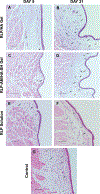Biocompatibility and Viscoelastic Properties of Injectable Resilin-Like Polypeptide and Hyaluronan Hybrid Hydrogels in Rabbit Vocal Folds
- PMID: 33829078
- PMCID: PMC8022864
- DOI: 10.1007/s40883-019-00094-6
Biocompatibility and Viscoelastic Properties of Injectable Resilin-Like Polypeptide and Hyaluronan Hybrid Hydrogels in Rabbit Vocal Folds
Abstract
Vocal fold scar, characterized by alterations in the lamina propria extracellular matrix, disrupts normal voice quality and function. Due to a lack of satisfactory clinical treatments, there is a need for tissue engineering strategies to restore voice. Candidate biomaterials for vocal fold tissue engineering must match the unique biomechanical and viscoelastic properties of native tissue without provoking inflammation. We sought to introduce elastomeric properties to hyaluronic acid (HA)-based biomaterials by incorporating resilin-like polypeptide (RLP) into hybrid hydrogels. Physically crosslinked RLP/HA and chemically crosslinked RLP-acrylamide/thiolated HA (RLP-AM/HA-SH) hydrogels were fabricated using cytocompatible chemistries. Mechanical properties of hydrogels were assessed in vitro using oscillatory rheology. Hybrid hydrogels were injected into rabbit vocal folds and tissues were assessed using rheology and histology. A small number of animals underwent acute vocal fold injury followed by injection of RLP-AM/HA-SH hydrogel alone or as a carrier for human bone marrow mesenchymal stem cells (BM-MSCs). Rheological testing confirmed that mechanical properties of materials in vitro resembled native vocal fold tissue and that viscoelasticity of vocal fold mucosa was preserved days 5 and 21 after injection. Histological analysis revealed that hybrid hydrogels provoked only mild inflammation in vocal fold lamina propria with demonstrated safety in the airway for up to 3 weeks, confirming acute biocompatibility of crosslinking chemistries. After acute injury, RLP-AM/HA-SH gel with and without BM-MSCs did not result in adverse effects or increased inflammation. Collectively, results indicate that RLP and HA-based hybrid hydrogels are highly promising for engineering the vocal fold lamina propria.
Keywords: Biocompatibility; Injectable hydrogels; Resilin; Viscoelastic properties; Vocal folds.
Conflict of interest statement
Conflict of Interest The authors declare that they have no conflict of interest.
Figures







Similar articles
-
Biocompatibility of injectable resilin-based hydrogels.J Biomed Mater Res A. 2018 Aug;106(8):2229-2242. doi: 10.1002/jbm.a.36418. Epub 2018 May 11. J Biomed Mater Res A. 2018. PMID: 29611890 Free PMC article.
-
Incorporation of types I and III collagen in tunable hyaluronan hydrogels for vocal fold tissue engineering.Acta Biomater. 2019 Mar 15;87:97-107. doi: 10.1016/j.actbio.2019.01.058. Epub 2019 Jan 30. Acta Biomater. 2019. PMID: 30708064 Free PMC article.
-
In Vivo engineering of the vocal fold ECM with injectable HA hydrogels-late effects on tissue repair and biomechanics in a rabbit model.J Voice. 2011 Mar;25(2):249-53. doi: 10.1016/j.jvoice.2009.10.003. Epub 2010 Apr 24. J Voice. 2011. PMID: 20456912 Free PMC article.
-
A Review of Hyaluronic Acid and Hyaluronic Acid-based Hydrogels for Vocal Fold Tissue Engineering.J Voice. 2017 Jul;31(4):416-423. doi: 10.1016/j.jvoice.2016.11.014. Epub 2017 Mar 2. J Voice. 2017. PMID: 28262503 Free PMC article. Review.
-
Hyaluronic acid hydrogels for vocal fold wound healing.Biomatter. 2013 Jan-Mar;3(1):e23799. doi: 10.4161/biom.23799. Epub 2013 Jan 1. Biomatter. 2013. PMID: 23507923 Free PMC article. Review.
Cited by
-
Resilin-mimetics as a smart biomaterial platform for biomedical applications.Nat Commun. 2021 Jan 8;12(1):149. doi: 10.1038/s41467-020-20375-x. Nat Commun. 2021. PMID: 33420053 Free PMC article. Review.
-
Application of Thermoresponsive Intrinsically Disordered Protein Polymers in Nanostructured and Microstructured Materials.Macromol Biosci. 2021 Sep;21(9):e2100129. doi: 10.1002/mabi.202100129. Epub 2021 Jun 18. Macromol Biosci. 2021. PMID: 34145967 Free PMC article. Review.
-
Engineered Protein Hydrogels as Biomimetic Cellular Scaffolds.Adv Mater. 2024 Nov;36(45):e2407794. doi: 10.1002/adma.202407794. Epub 2024 Sep 5. Adv Mater. 2024. PMID: 39233559 Review.
-
Design and applications of self-assembled polypeptide matrices in wound healing.Front Bioeng Biotechnol. 2025 Aug 11;13:1646622. doi: 10.3389/fbioe.2025.1646622. eCollection 2025. Front Bioeng Biotechnol. 2025. PMID: 40861854 Free PMC article. Review.
-
Brown Adipose Stem Cell-Loaded Resilin Elastic Hydrogel Rebuilds Cardiac Function after Myocardial Infarction via Collagen I/III Reorganisation.Gels. 2024 Aug 31;10(9):568. doi: 10.3390/gels10090568. Gels. 2024. PMID: 39330170 Free PMC article.
References
-
- Hirano M Morphological structure of the vocal cord as a vibrator and its variations. Folia Phoniatr. 1974;26:89–94. - PubMed
-
- Hirano M, Kurita S, Nakashima T. The structure of the vocal folds. In: Stevens KN, Hirano M, editors. Vocal fold physiology. Tokyo: University of Tokyo Press; 1981. p. 33–43.
-
- Gray SD. Cellular physiology of the vocal folds. Otolaryngol Clin N Am. 2000;33:679–98. - PubMed
-
- Gray SD, Alipour F, Titze IR, Hammond TH. Biomechanical and histologic observations of vocal fold fibrous proteins. Ann Otol Rhinol Laryngol. 2000;109:77–85. - PubMed
-
- Woo P, Casper J, Colton R, Brewer D. Diagnosis and treatment of persistent dysphonia after laryngeal surgery: a retrospective analysis of 62 patients. Laryngoscope. 1994;104:1084–91. - PubMed
Grants and funding
LinkOut - more resources
Full Text Sources
